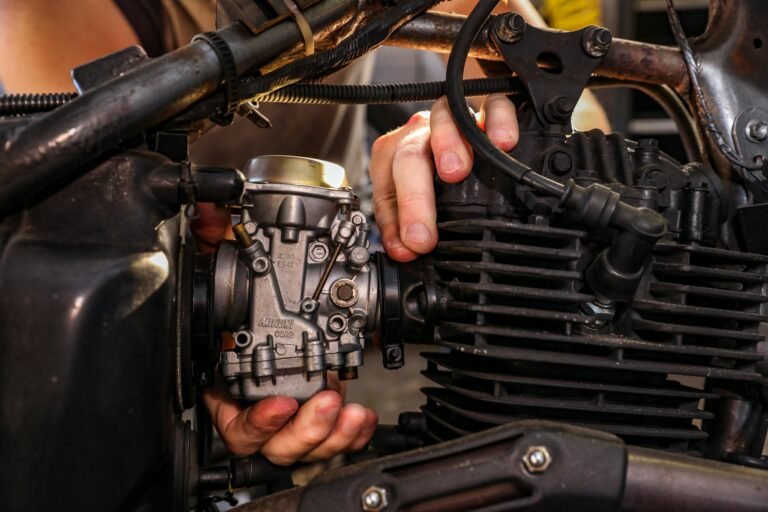What Is a Carburetor and Why Does Your Car Need the Part?
Carburetors mix air and fuel for internal combustion engines. They regulate the air-fuel ratio for optimal engine performance.
Carburetors are essential components in many internal combustion engines, playing a crucial role in engine performance. These devices precisely blend air and fuel, ensuring the mixture is ideal for combustion. Invented in the late 19th century, carburetors have evolved significantly over time.
They offer simplicity and reliability, particularly in older vehicles and machinery. Although modern engines often use fuel injection systems, carburetors remain popular in small engines like those in lawnmowers and motorcycles. Understanding how carburetors work can help in maintaining and troubleshooting engines. Proper maintenance ensures longer engine life and better fuel efficiency. Despite newer technologies, carburetors continue to be relevant in various applications.
Carburetor vs fuel injection
Carburetor and fuel injection are two different methods of delivering fuel to the engine in a vehicle. Here’s a breakdown of each system:
1. Carburetor:
- How It Works: A carburetor mixes air and fuel in the correct ratio before it enters the engine’s combustion chambers. It uses a series of jets, valves, and passages to achieve this mix, relying on air pressure changes to draw fuel from the float chamber.
- Advantages:
- Simplicity: Carburetors are mechanically simpler and often easier to repair and adjust.
- Cost: Generally, they are less expensive to manufacture and replace.
- Reliability: In older vehicles, carburetors can be quite reliable if maintained properly.
- Disadvantages:
- Efficiency: Carburetors can be less efficient in terms of fuel economy and emissions compared to modern fuel injection systems.
- Performance: They can be less precise in adjusting the air-fuel mixture, which can affect performance, especially in varying driving conditions.
2. Fuel Injection:
- How It Works: Fuel injection systems use electronic controls to precisely deliver fuel into the engine’s combustion chambers. Sensors monitor engine parameters (like temperature and air flow), and the engine control unit (ECU) adjusts the fuel delivery accordingly.
- Advantages:
- Efficiency: Fuel injection systems generally provide better fuel efficiency and lower emissions due to their precise control over the fuel-air mixture.
- Performance: They offer better performance and smoother operation, with quicker starts and more consistent power output.
- Adaptability: Modern systems can adapt to different driving conditions and fuel types, improving overall drivability.
- Disadvantages:
- Complexity: Fuel injection systems are more complex and can be more expensive to repair or replace.
What Is A Carburetor ?
A carburetor mixes air and fuel for internal combustion engines. This crucial component ensures optimal engine performance and efficiency.
Carburetors are fascinating components that have played a crucial role in the internal combustion engine for decades. They mix air and fuel in the right proportions to ensure efficient engine performance. But what exactly is a carburetor, and how does it work?
Let’s dive in.
Basic Function Of A Carburetor
A carburetor’s primary job is to blend air and fuel for the engine. This mixture is essential for combustion. It must be precise to achieve optimal performance and efficiency.
Components Of A Carburetor
Understanding the parts of a carburetor can simplify how it works. Here are the main components you should know:
- Throttle: Controls the engine’s power by regulating airflow.
- Float Chamber: Maintains a steady fuel level.
- Venturi: Creates a vacuum to draw fuel into the airstream.
- Choke: Regulates air intake for cold starts.
How A Carburetor Works
The operation of a carburetor involves several steps. Each step plays a vital role in ensuring the right air-fuel mix:
- Air enters through the intake.
- The venturi narrows, increasing airspeed and creating a vacuum.
- Fuel is drawn into the airstream from the float chamber.
- The throttle controls the amount of the mixture entering the engine.
Types Of Carburetors
Different carburetors are suited for various applications. Let’s look at some common types:
- Single-barrel: Used in smaller engines, simple in design.
- Two-barrel: Offers better fuel distribution, common in medium-sized engines.
- Four-barrel: Provides high performance, used in powerful engines.
Importance Of Carburetor Maintenance
Regular upkeep is essential for carburetors. Proper maintenance ensures they function efficiently:
- Clean regularly: Prevents clogs and ensures smooth operation.
- Adjust settings: Keeps the air-fuel ratio optimal.
- Inspect for wear: Identifies parts needing replacement.
Signs Of A Faulty Carburetor
Recognizing issues early can save you from bigger problems. Watch out for these signs:
- Engine stalling: Indicates a poor air-fuel mix.
- Black exhaust smoke: Suggests a rich fuel mixture.
- Poor fuel economy: Points to improper carburetor settings.
Carburetors are intricate yet vital components that ensure your engine runs smoothly. Understanding their function and maintenance can help you keep your vehicle in top shape.
What Does A Carburetor Do In An Engine?
A carburetor mixes air and fuel for internal combustion engines. This crucial component ensures optimal fuel efficiency and engine performance.
A carburetor is a crucial component in many internal combustion engines, yet its function often remains a mystery. Understanding what a carburetor does can help you appreciate how your engine runs smoothly.
Mixing Air And Fuel
The primary role of a carburetor is to blend air and fuel for the engine. This mixture is essential for combustion. Without it, the engine cannot generate power.
Controlling Airflow
To ensure the right air-to-fuel ratio, the carburetor regulates airflow into the engine. This is done through a throttle valve. The throttle valve opens and closes based on engine demands, adjusting the air intake accordingly.
Fuel Atomization
Fuel atomization is another critical function. The carburetor breaks down fuel into tiny particles, creating a fine mist. This mist mixes evenly with the air, allowing for efficient combustion.
Maintaining Fuel Levels
The carburetor maintains a consistent fuel level in the float chamber. This ensures a steady supply of fuel to the engine. Here are some key points:
- Float Valve: Controls the fuel inlet.
- Float Chamber: Stores the fuel before it enters the main chamber.
- Overflow Pipe: Prevents flooding by diverting excess fuel.
Adjusting Mixture For Conditions
The carburetor adjusts the air-fuel mixture based on various conditions. For instance, it enriches the mixture during cold starts and leans it out when the engine is warm.
Enhancing Engine Performance
Lastly, a well-functioning carburetor boosts engine performance. It ensures optimal combustion, leading to better fuel efficiency and power output.
Benefits Of Carburetors
Carburetors enhance engine performance by precisely mixing air and fuel, ensuring efficient combustion. They also offer easy maintenance and repair, making them ideal for older vehicles.
Carburetors have long been a staple in engine technology, offering numerous advantages that make them a popular choice for various applications. They play a crucial role in mixing air and fuel for internal combustion engines, optimizing performance and efficiency.
Enhanced Fuel Atomization
A well-designed carburetor ensures optimal fuel atomization. This means the fuel is broken down into fine droplets, which mix more effectively with air.
- Improved combustion: Results in better engine performance.
- Reduced emissions: Less unburned fuel means fewer pollutants.
- Smoother engine operation: Consistent fuel-air mix leads to smoother running engines.
Simplicity And Cost-effectiveness
Carburetors are known for their straightforward design. This simplicity translates into several practical benefits.
- Easy maintenance: Fewer components mean less can go wrong.
- Cost-effective: Cheaper to produce and repair compared to fuel injection systems.
- User-friendly: Easier for DIY enthusiasts to understand and work on.
Versatility Across Applications
Carburetors are versatile and can be used in a wide range of engines. This adaptability makes them ideal for various uses.
From lawnmowers to classic cars, they provide a reliable option. Their ability to function in different environments adds to their appeal.
Better Throttle Response
One of the standout benefits is the superior throttle response. This is especially appreciated in high-performance applications.
- Immediate power delivery: Quick response to throttle inputs.
- Enhanced driving experience: More control and feedback for the driver.
- Suitable for performance tuning: Easily adjustable to meet specific needs.
Reliability In Older Engines
Carburetors have a proven track record in older engines. This reliability is a key factor for many enthusiasts.
- Consistent performance: Well-maintained carburetors perform reliably over time.
- Compatibility: Perfect for vintage and classic vehicles.
- Simplicity in diagnostics: Easier to diagnose and fix issues without advanced equipment.
Improved Fuel Efficiency
When fine-tuned, carburetors can significantly improve fuel efficiency. This is a crucial advantage in both performance and everyday applications.
- Better mileage: Optimized fuel-air mix leads to less fuel consumption.
- Cost savings: Reduced fuel usage means lower operating costs.
- Eco-friendly: Enhanced efficiency results in fewer emissions.
Customization And Tuning
Carburetors offer a high degree of customization. This makes them popular among performance enthusiasts and hobbyists.
- Adjustable settings: Fine-tune for specific performance needs.
- Wide range of aftermarket options: Numerous parts available for upgrades.
- Personalization: Allows for a unique setup tailored to individual preferences.
Durability And Longevity
Carburetors are built to last, offering durability and longevity. This robustness is beneficial for various applications.
- Sturdy construction: Designed to withstand harsh conditions.
- Long-lasting: Properly maintained carburetors can last for decades.
- Dependable: Reliable performance over an extended period.
Historical Significance
Carburetors hold a significant place in automotive history. Their impact on engine technology is undeniable.
- Classic appeal: Often preferred in restoration projects.
- Historical value: Integral part of automotive heritage.
- Nostalgia: Brings a sense of tradition to modern enthusiasts.
Ease Of Troubleshooting
Finally, carburetors are easier to troubleshoot compared to modern fuel injection systems. This ease of maintenance is a major advantage.
- Simple diagnostics: Issues can often be identified visually.
- Fewer electronic components: Reduces the complexity of potential problems.
- Accessible repairs: Most repairs can be done with basic tools.
Carburetor Vs. Fuel Injection What’s The Difference?
Carburetors mix air and fuel for internal combustion engines, offering simplicity and ease of maintenance. They rely on mechanical parts and vacuum pressure to function effectively. Known for their vintage appeal, carburetors provide a straightforward approach to fuel delivery.
Carburetors and fuel injection systems both play crucial roles in managing your engine’s fuel and air mixture. Despite sharing a common goal, they achieve it through different methods. Let’s dive into the distinctions between carburetors and fuel injection systems.
How Carburetors Work
Carburetors have been around since the early days of automotive engineering. They mix air and fuel in a specific ratio and deliver it to the engine.
- Air intake: Air enters through the top of the carburetor.
- Fuel delivery: A jet injects fuel into the air stream.
- Mixing: Air and fuel blend in the venturi, a narrow part of the carburetor.
- Delivery: The mixture flows into the engine for combustion.
How Fuel Injection Works
In contrast, fuel injection systems use advanced technology for precise fuel delivery. These systems offer better efficiency and performance.
Fuel injectors spray fuel directly into the engine’s combustion chamber or intake manifold. This process is electronically controlled, ensuring optimal fuel delivery for various conditions.
Efficiency And Performance
Fuel injection systems generally outperform carburetors in terms of efficiency and performance. Here’s why:
- Precision: Fuel injectors deliver fuel more accurately.
- Adaptability: They adjust to different driving conditions automatically.
- Fuel economy: Better fuel atomization leads to improved mileage.
- Emissions: Reduced emissions due to cleaner fuel burn.
Maintenance And Cost
Both systems require maintenance, but the nature and frequency of this maintenance differ. Let’s compare:
- Carburetors: Require regular cleaning and adjustment.
- Fuel Injectors: Need occasional cleaning but fewer adjustments.
- Cost: Carburetors are cheaper to repair, while fuel injection systems can be more costly.
Suitability For Different Vehicles
Each system has its own set of advantages, making them suitable for different types of vehicles.
- Classic cars: Often use carburetors due to simplicity and ease of repair.
- Modern vehicles: Typically rely on fuel injection for efficiency and performance.
- High-performance cars: Benefit from the precision of fuel injectors.
Understanding these differences helps you make an informed choice about which system best suits your vehicle’s needs.
Signs Of A Failing Carburetor
Trouble starting the engine or experiencing sluggish acceleration often indicates a failing carburetor. Black smoke from the exhaust also signals carburetor issues. Rough idling or frequent stalling could mean the carburetor needs attention.
A smooth-running engine is a joy for any driver, but a failing carburetor can quickly spoil the fun. Recognizing early signs of carburetor issues can save you time and money. Let’s dive into the telltale signs that your carburetor might be on its last legs.
Engine Misfires
Engine misfires often signal a carburetor problem. If your engine stumbles or hesitates, it might be due to:
- Air-fuel mixture imbalance: Incorrect ratios can cause incomplete combustion.
- Dirty jets: Clogged jets prevent proper fuel flow.
- Malfunctioning choke: The choke may not be regulating airflow correctly.
Poor Fuel Economy
Notice you’re filling up more often? That could be a sign. Poor fuel economy is a common symptom of carburetor issues. A faulty carburetor might:
- Deliver too much fuel: Leads to excessive consumption.
- Cause improper combustion: Reduces engine efficiency.
- Leak fuel: Wastes fuel and poses safety risks.
Hard Starting
Struggling to start your engine? Hard starting can indicate a failing carburetor. This issue often arises from:
- Faulty choke: Makes cold starts difficult.
- Fuel delivery issues: Insufficient fuel reaching the engine.
- Air leaks: Disturb the air-fuel mixture balance.
Black Smoke From The Exhaust
Black smoke is never a good sign. It usually means the carburetor is running too rich. Common causes include:
- Stuck float: Allows too much fuel into the carburetor.
- Rich mixture settings: Carburetor settings may be too rich.
- Dirty air filter: Restricts airflow, causing excess fuel.
Rough Idling
Your engine should purr at idle, not struggle. Rough idling can be a clear indicator of carburetor trouble. This condition may result from:
- Clogged jets: Block fuel flow during idle.
- Incorrect idle settings: Misadjusted settings can disrupt smooth idling.
- Vacuum leaks: Cause erratic idling and poor performance.
Engine Stalling
An engine that stalls frequently can be frustrating. Carburetor-related stalling often stems from:
- Fuel delivery problems: Inadequate fuel reaching the engine.
- Idle speed issues: Incorrect idle speed settings.
- Dirty carburetor: Build-up of debris and deposits.
Recognizing these signs early can help maintain your vehicle’s performance and prevent further damage. Keep an eye out for these symptoms and address any carburetor issues promptly.
Maintenance And Tuning Of Carburetors
Maintaining and tuning carburetors ensures optimal engine performance and fuel efficiency. Regular inspections and adjustments keep the engine running smoothly. Proper care extends the lifespan of your vehicle’s carburetor.
Maintaining and tuning carburetors can significantly enhance your vehicle’s performance. Proper care ensures smooth operation and longevity of this critical engine component.
Regular Cleaning
To keep carburetors functioning efficiently, regular cleaning is essential. Dirty carburetors can cause poor fuel economy and sluggish acceleration.
- Disassemble the carburetor: Remove all parts for thorough cleaning.
- Use a carburetor cleaner: Apply cleaner to remove gum, varnish, and debris.
- Inspect jets and passages: Ensure they are free of blockages for proper fuel flow.
- Reassemble carefully: Make sure all parts are correctly put back in place.
Adjusting The Air-fuel Mixture
Achieving the right air-fuel ratio is crucial for optimal engine performance. This balance can impact fuel economy and emissions.
The adjustment process typically involves:
- Locating the mixture screws: Usually found on the carburetor body.
- Turning the screws: Adjust until you achieve a smooth idle.
- Using a vacuum gauge: Helps in fine-tuning the mixture for precise adjustments.
- Listening to engine sound: A steady and smooth sound indicates a proper mixture.
Checking For Leaks
Leaks in the carburetor can lead to performance issues and potential engine damage. Regular checks can prevent these problems.
- Inspect gaskets and seals: Look for any signs of wear or cracks.
- Check fuel lines: Ensure they are secure and not leaking.
- Test for vacuum leaks: Use a spray to detect any changes in engine speed.
- Tighten connections: Make sure all bolts and screws are properly tightened.
Synchronizing Multiple Carburetors
For vehicles with multiple carburetors, synchronization is vital. It ensures all carburetors work together for balanced performance.
- Use a synchronizing tool: Helps match the airflow between carburetors.
- Adjust throttle linkages: Ensure they open and close simultaneously.
- Check idle speed: Adjust each carburetor to achieve a consistent idle.
- Test drive: Confirm that the engine runs smoothly under various conditions.
Inspecting The Float Level
The float level controls the fuel level within the carburetor. Incorrect levels can cause flooding or fuel starvation.
- Remove the carburetor bowl: Gain access to the float.
- Measure the float height: Use a ruler or caliper.
- Adjust the float tab: Bend carefully to achieve the correct height.
- Reassemble and test: Ensure the fuel level is steady and within specifications.
Replacing Worn Parts
Over time, carburetor components can wear out, affecting performance. Regular inspection and replacement of worn parts are crucial.
- Inspect moving parts: Look for wear on throttle shafts and linkages.
- Check diaphragms: Replace any that are cracked or stiff.
- Review gaskets: Ensure they are intact and sealing properly.
- Update jets and needles: Replace if they show signs of wear or damage.
Conclusion
Understanding carburetors is crucial for optimal engine performance. Regular maintenance ensures longevity and efficiency. Whether you’re a car enthusiast or a DIY mechanic, knowing how carburetors work is invaluable. Keep your vehicle running smoothly by staying informed and proactive. Dive deeper into carburetor care and enjoy a hassle-free driving experience.

At AdjustCarburetor, we are passionate about optimizing engine performance and sharing our expertise in carburetors, small engines, fuel injection systems, air-fuel ratios, and ignition timing solutions





